2018 SUBARU CROSSTREK ECU
[x] Cancel search: ECUPage 10 of 474

(9,1)
北米Model "A1320BE-C" EDITED: 2017/ 10/ 10
Never drive if you are under the influence
of any illicit mind-altering drugs. For your
own health and well-being, we urge you
not to take illegal drugs in the first place
and to seek treatment if you are addicted
to those drugs.&Driving when tired or sleepy
WARNING
When you are tired or sleepy, your
reaction time will be delayed and
your perception, judgment and at-
tentiveness will be impaired. If you
drive when tired or sleepy, your,
your passengers’and other per-
sons’chances of being involved in
a serious accident may increase.
Please do not continue to drive but instead
find a safe place to rest if you are tired or
sleepy. On long trips, you should make
periodic rest stops to refresh yourself
before continuing on your journey. When
possible, you should share the driving with
others.
&Modification of your vehicle
CAUTION
Your vehicle should not be modified
other than with genuine SUBARU
parts and accessories. Other types
of modifications could affect its
performance, safety or durability,
and may even violate governmental
regulations. In addition, damage or
performance problems resulting
from modification may not be cov-
ered under warranties.&Use of cell phones/texting
and driving
CAUTION
Do not talk on a cell phone or text
while driving; it may distract your
attention from driving and lead to an
accident. If you use a cell phone to
talk or text, first pull off the road and
park in a safe place. In some States/
Provinces, it may be lawful to talk on
a phone while driving, but only if the
phone is hands-free.
&Driving vehicles equipped
with navigation system
WARNING
Do not allow the monitor to distract
your attention from driving. Also, do
not operate the controls of the
navigation system while driving.
The loss of attention to driving could
lead to an accident. If you wish to
operate the controls of the naviga-
tion system, first take the vehicle off
the road and stop it in a safe
location.&Driving with petsUnrestrained pets can interfere with your
driving and distract your attention from
driving. In a collision or sudden stop,
unrestrained pets or cages can be thrown
around inside the vehicle and hurt you or
your passengers. Besides, the pets can be
hurt under these situations. It is also for
their own safety that pets should be
properly restrained in your vehicle. Re-
strain a pet with a special traveling harness
which can be secured to the rear seat with
a seatbelt or use a pet carrier which can be
secured to the rear seat by routing a
seatbelt through the carrier’s handle.
–CONTINUED–
7
0
Page 11 of 474

(10,1)
北米Model "A1320BE-C" EDITED: 2017/ 10/ 10
Never restrain pets or pet carriers in the
front passenger’s seat. For further infor-
mation, consult your veterinarian, local
animal protection society or pet shop.&Tire pressuresCheck and, if necessary, adjust the pres-
sure of each tire (including the spare) at
least once a month and before any long
journey.
Check the tire pressure when the tires are
cold. Use a pressure gauge to adjust the
tire pressures to the values shown on the
tire placard. For detailed information, refer
to“Tires and wheels”F11-21.
WARNING
Driving at high speeds with exces-
sively low tire pressures can cause
the tires to deform severely and to
rapidly become hot. A sharp in-
crease in temperature could cause
tread separation, and destruction of
the tires. The resulting loss of vehi-
cle control could lead to an accident.
&Attaching accessories
WARNING
.Do not attach any accessories,
labels or stickers (other than
properly placed inspection stick-
ers) to the windshield. Such
items may obstruct your view.
.If it is necessary to attach an
accessory (such as an electronic
toll collection (ETC) device or
security pass) to the windshield,
consult your SUBARU dealer for
details on the proper location.
General information&California proposition 65
warning
WARNING
Engine exhaust, some of its consti-
tuents, and certain vehicle compo-
nents contain or emit chemicals
known to the State of California to
cause cancer and birth defects or
other reproductive harm. In addi-
tion, certain fluids in vehicles and
certain components of product wear
contain or emit chemicals known to
the State of California to cause
cancer and birth defects or other
reproductive harm.&California Perchlorate Advi-
soryCertain vehicle components such as air-
bag modules, seatbelt pretensioners and
keyless entry transmitter batteries may
contain perchlorate material. Special
handling may apply for service or vehicle
end of life disposal. See www.dtsc.ca.gov/
hazardouswaste/perchlorate.
8
Page 26 of 474
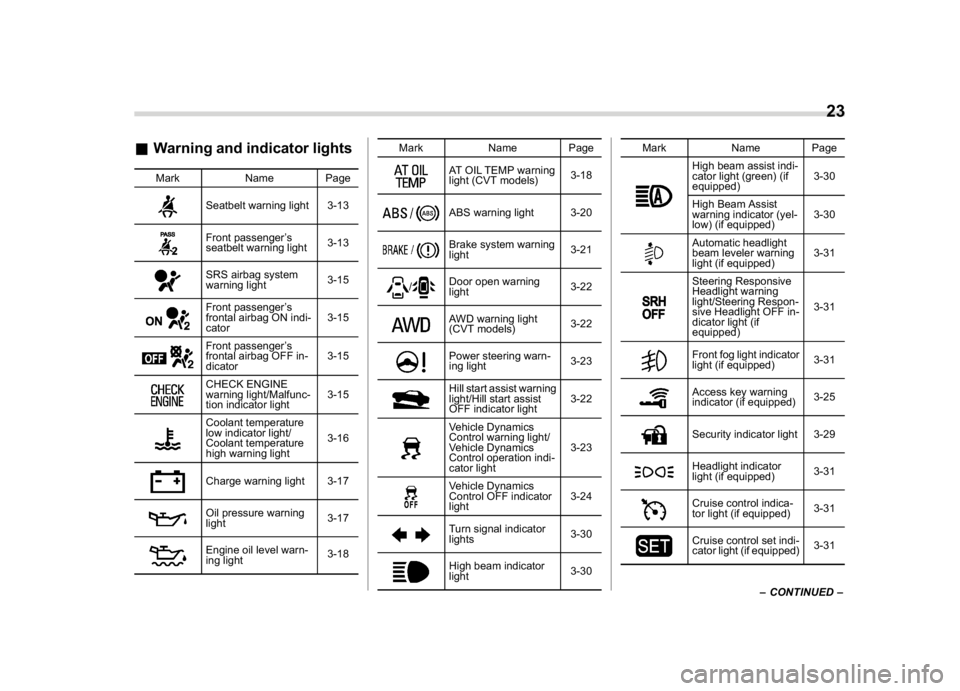
(25,1)
北米Model "A1320BE-C" EDITED: 2017/ 10/ 10
&Warning and indicator lights
Mark Name Page
Seatbelt warning light 3-13Front passenger’s
seatbelt warning light3-13SRS airbag system
warning light3-15Front passenger’s
frontal airbag ON indi-
cator3-15Front passenger’s
frontal airbag OFF in-
dicator3-15CHECK ENGINE
warning light/Malfunc-
tion indicator light3-15Coolant temperature
low indicator light/
Coolant temperature
high warning light3-16Charge warning light 3-17Oil pressure warning
light3-17Engine oil level warn-
ing light3-18Mark Name Page
AT OIL TEMP warning
light (CVT models)3-18ABS warning light 3-20Brake system warning
light3-21
/
Door open warning
light3-22AWD warning light
(CVT models)3-22Power steering warn-
ing light3-23Hill start assist warning
light/Hill start assist
OFF indicator light3-22Vehicle Dynamics
Control warning light/
Vehicle Dynamics
Control operation indi-
cator light3-23Vehicle Dynamics
Control OFF indicator
light3-24Turn signal indicator
lights3-30High beam indicator
light3-30Mark Name Page
High beam assist indi-
cator light (green) (if
equipped)3-30
High Beam Assist
warning indicator (yel-
low) (if equipped)3-30Automatic headlight
beam leveler warning
light (if equipped)3-31Steering Responsive
Headlight warning
light/Steering Respon-
sive Headlight OFF in-
dicator light (if
equipped)3-31Front fog light indicator
light (if equipped)3-31Access key warning
indicator (if equipped)3-25Security indicator light 3-29Headlight indicator
light (if equipped)3-31Cruise control indica-
tor light (if equipped)3-31Cruise control set indi-
cator light (if equipped)3-31
–CONTINUED–
23
0
Page 31 of 474
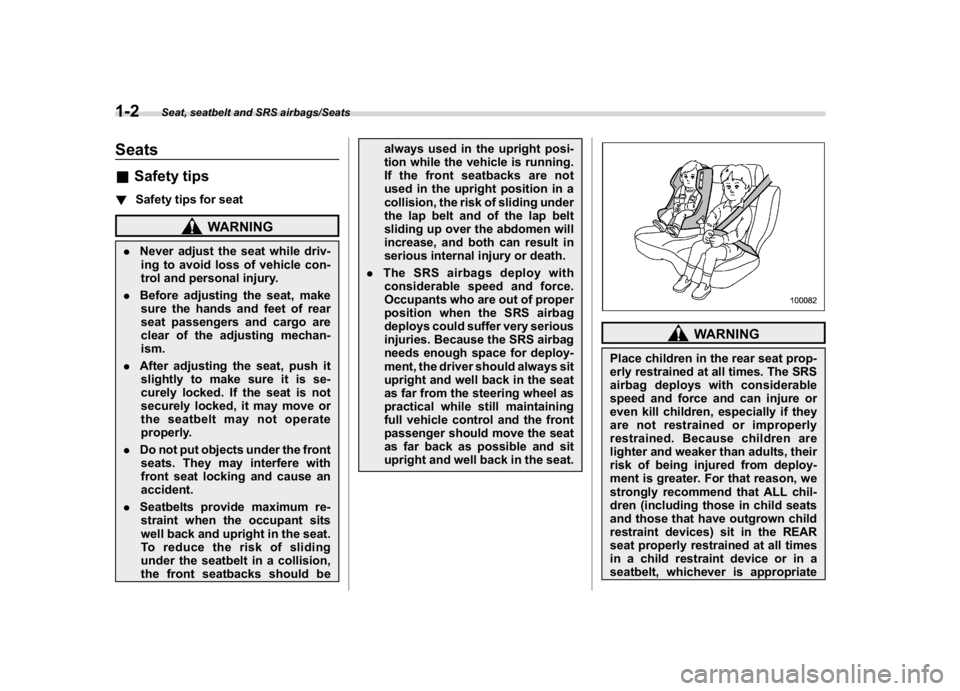
(32,1)
北米Model "A1320BE-C" EDITED: 2017/ 10/ 10
Seats&Safety tips!Safety tips for seat
WARNING
.Never adjust the seat while driv-
ing to avoid loss of vehicle con-
trol and personal injury.
.Before adjusting the seat, make
sure the hands and feet of rear
seat passengers and cargo are
clear of the adjusting mechan-
ism.
.After adjusting the seat, push it
slightly to make sure it is se-
curely locked. If the seat is not
securely locked, it may move or
the seatbelt may not operate
properly.
.Do not put objects under the front
seats. They may interfere with
front seat locking and cause an
accident.
.Seatbelts provide maximum re-
straint when the occupant sits
well back and upright in the seat.
To reduce the risk of sliding
under the seatbelt in a collision,
the front seatbacks should bealways used in the upright posi-
tion while the vehicle is running.
If the front seatbacks are not
used in the upright position in a
collision, the risk of sliding under
the lap belt and of the lap belt
sliding up over the abdomen will
increase, and both can result in
serious internal injury or death.
.The SRS airbags deploy with
considerable speed and force.
Occupants who are out of proper
position when the SRS airbag
deploys could suffer very serious
injuries. Because the SRS airbag
needs enough space for deploy-
ment, the driver should always sit
upright and well back in the seat
as far from the steering wheel as
practical while still maintaining
full vehicle control and the front
passenger should move the seat
as far back as possible and sit
upright and well back in the seat.
WARNING
Place children in the rear seat prop-
erly restrained at all times. The SRS
airbag deploys with considerable
speed and force and can injure or
even kill children, especially if they
are not restrained or improperly
restrained. Because children are
lighter and weaker than adults, their
risk of being injured from deploy-
ment is greater. For that reason, we
strongly recommend that ALL chil-
dren (including those in child seats
and those that have outgrown child
restraint devices) sit in the REAR
seat properly restrained at all times
in a child restraint device or in a
seatbelt, whichever is appropriate
Seat, seatbelt and SRS airbags/Seats
1-2
Page 32 of 474
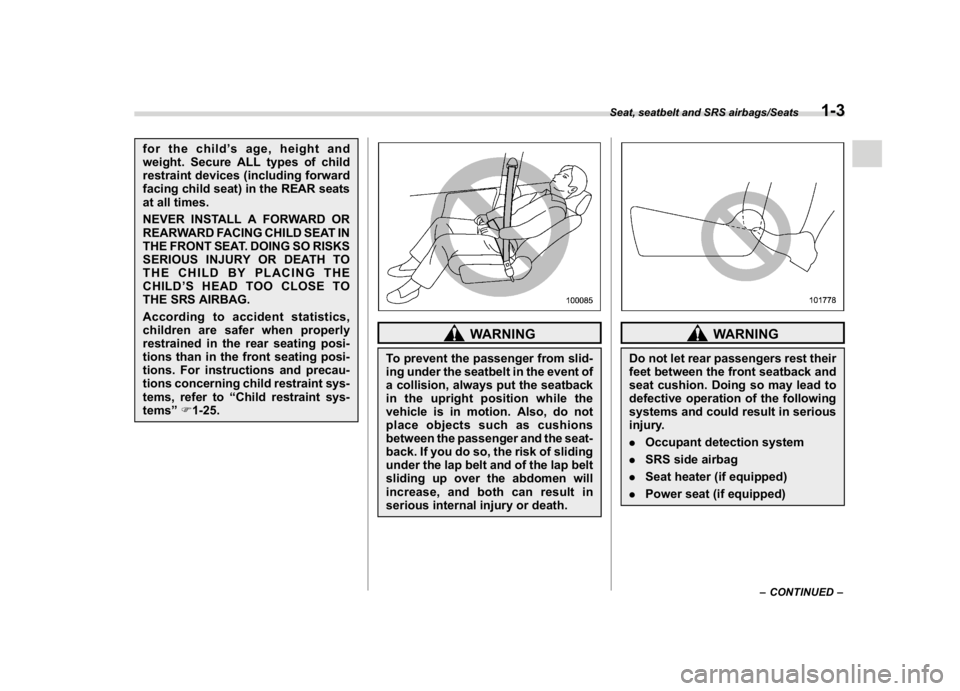
(33,1)
北米Model "A1320BE-C" EDITED: 2017/ 10/ 10
for the child’s age, height and
weight. Secure ALL types of child
restraint devices (including forward
facing child seat) in the REAR seats
at all times.
NEVER INSTALL A FORWARD OR
REARWARD FACING CHILD SEAT IN
THE FRONT SEAT. DOING SO RISKS
SERIOUS INJURY OR DEATH TO
THE CHILD BY PLACING THE
CHILD’S HEAD TOO CLOSE TO
THE SRS AIRBAG.
According to accident statistics,
children are safer when properly
restrained in the rear seating posi-
tions than in the front seating posi-
tions. For instructions and precau-
tions concerning child restraint sys-
tems, refer to“Child restraint sys-
tems”F1-25.
WARNING
To prevent the passenger from slid-
ing under the seatbelt in the event of
a collision, always put the seatback
in the upright position while the
vehicle is in motion. Also, do not
place objects such as cushions
between the passenger and the seat-
back. If you do so, the risk of sliding
under the lap belt and of the lap belt
sliding up over the abdomen will
increase, and both can result in
serious internal injury or death.
WARNING
Do not let rear passengers rest their
feet between the front seatback and
seat cushion. Doing so may lead to
defective operation of the following
systems and could result in serious
injury.
.Occupant detection system
.SRS side airbag
.Seat heater (if equipped)
.Power seat (if equipped)
–CONTINUED–
Seat, seatbelt and SRS airbags/Seats
1-3
1
Page 34 of 474
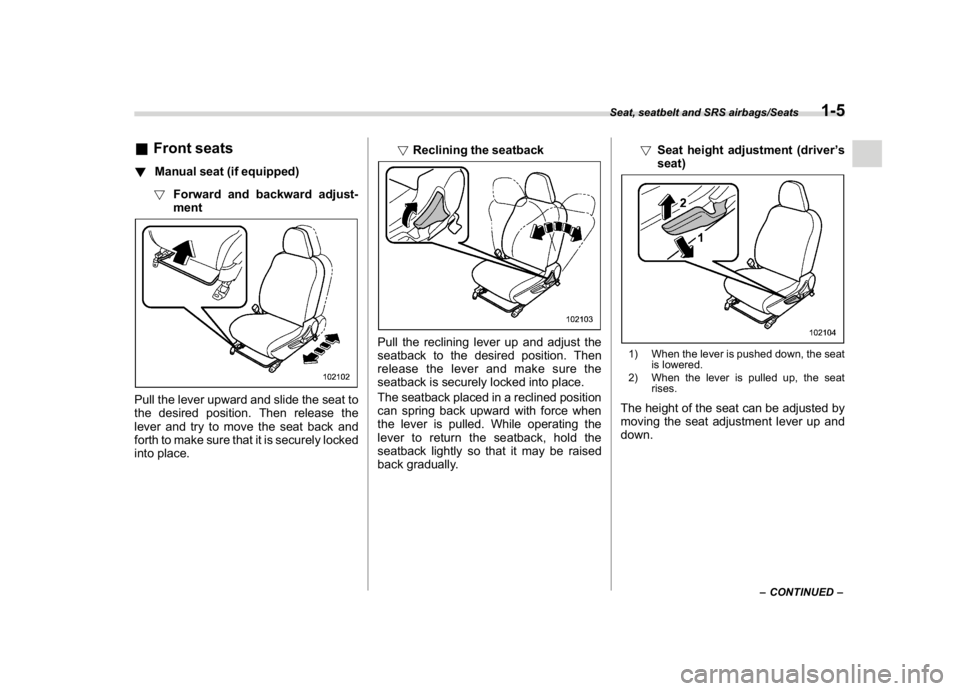
(35,1)
北米Model "A1320BE-C" EDITED: 2017/ 10/ 10
&Front seats!Manual seat (if equipped)
!Forward and backward adjust-
mentPull the lever upward and slide the seat to
the desired position. Then release the
lever and try to move the seat back and
forth to make sure that it is securely locked
into place.!Reclining the seatback
Pull the reclining lever up and adjust the
seatback to the desired position. Then
release the lever and make sure the
seatback is securely locked into place.
The seatback placed in a reclined position
can spring back upward with force when
the lever is pulled. While operating the
lever to return the seatback, hold the
seatback lightly so that it may be raised
back gradually.!Seat height adjustment (driver’s
seat)
1) When the lever is pushed down, the seat
is lowered.
2) When the lever is pulled up, the seat
rises.The height of the seat can be adjusted by
moving the seat adjustment lever up and
down.
–CONTINUED–
Seat, seatbelt and SRS airbags/Seats
1-5
1
Page 35 of 474
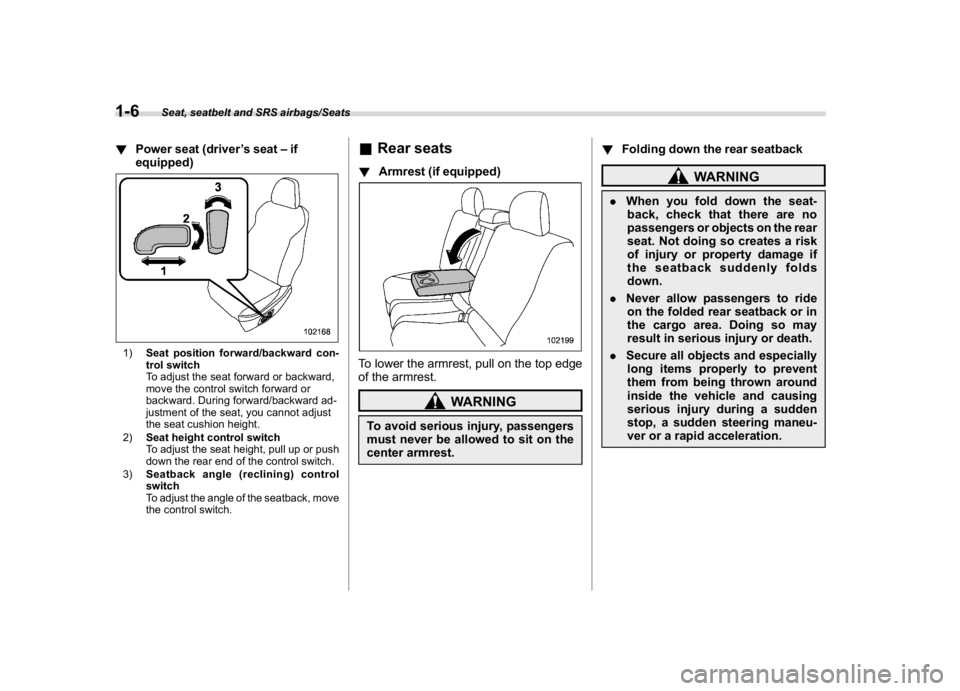
(36,1)
北米Model "A1320BE-C" EDITED: 2017/ 10/ 10
!Power seat (driver’s seat–if
equipped)1)Seat position forward/backward con-
trol switch
To adjust the seat forward or backward,
move the control switch forward or
backward. During forward/backward ad-
justment of the seat, you cannot adjust
the seat cushion height.
2)Seat height control switch
To adjust the seat height, pull up or push
down the rear end of the control switch.
3)Seatback angle (reclining) control
switch
To adjust the angle of the seatback, move
the control switch.
&Rear seats!Armrest (if equipped)To lower the armrest, pull on the top edge
of the armrest.
WARNING
To avoid serious injury, passengers
must never be allowed to sit on the
center armrest.!Folding down the rear seatback
WARNING
.When you fold down the seat-
back, check that there are no
passengers or objects on the rear
seat. Not doing so creates a risk
of injury or property damage if
the seatback suddenly folds
down.
.Never allow passengers to ride
on the folded rear seatback or in
the cargo area. Doing so may
result in serious injury or death.
.Secure all objects and especially
long items properly to prevent
them from being thrown around
inside the vehicle and causing
serious injury during a sudden
stop, a sudden steering maneu-
ver or a rapid acceleration.
Seat, seatbelt and SRS airbags/Seats
1-6
Page 36 of 474

(37,1)
北米Model "A1320BE-C" EDITED: 2017/ 10/ 10
Unlock the seatback by pulling the lock
release knob and then fold the seatback
down.
!Return the rear seatback
WARNING
When returning the seatback to its
original position, observe the fol-
lowing precaution.
Failure to observe the precaution
may damage the seatbelt, impairing
its effectiveness, and possibly re-
sult in a serious injury.
.When returning the seatback to
its original position, pull the
seatbelt out towards the vehicle
exterior so that it will not be
caught between the seatback
and the trim.
Lock release knob
1) Unlocked
2) Locked
A) Unlocking marker in redTo return the seatback to its original
position, raise the seatback until it locks
into place and make sure that the unlock-
ing marker on the lock release knob is no
longer visible.
WARNING
When you return the seatback to its
original position, check that the
unlocking marker on the lock re-
lease knob is not visible. Also, shake
the seatback slightly to confirm that
it is securely fixed in place. If the
seatback is not securely fixed in
place, the seatback may suddenly
–CONTINUED–
Seat, seatbelt and SRS airbags/Seats
1-7
1